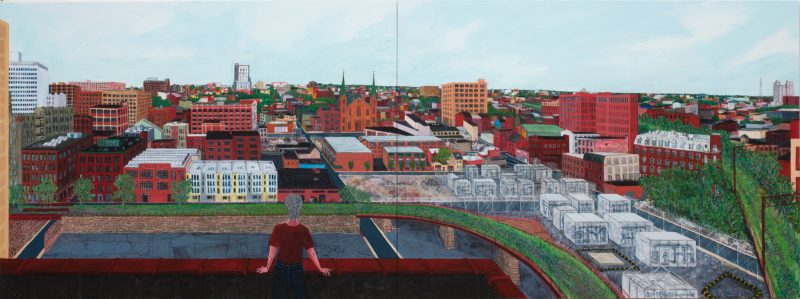
“. . . The rare privilege of being with a person who is past the need to say anything but what needs to be said.”
Ursula K Le Guin’s review of Kent Haruf’s Our Souls at Night (written while Haruf was dying). The Guardian (May 27, 2015)
A glimpse into a consciousness of the moment
You don’t have to be a dog or cat lover (indeed I am not); you don’t have to be a Philadelphian; you don’t have to know anything about the artist’s past or present personal or professional life; you don’t have to know anything about her politics or her activism (or her pets); you don’t even have to know anything about art to enjoy When You Wish, Sarah McEneaney’s exhibition of 16 new works now up at the stately Locks Gallery. There is nothing esoteric, mysterious, pretentious, assuming, conceptual, or even symbolic about this collection of McEneaney’s work. It is essentially an extremely appealing and artistically unique glimpse into a consciousness of the moment that potentially could be shared by any seeing person in his or her own particular time and place.
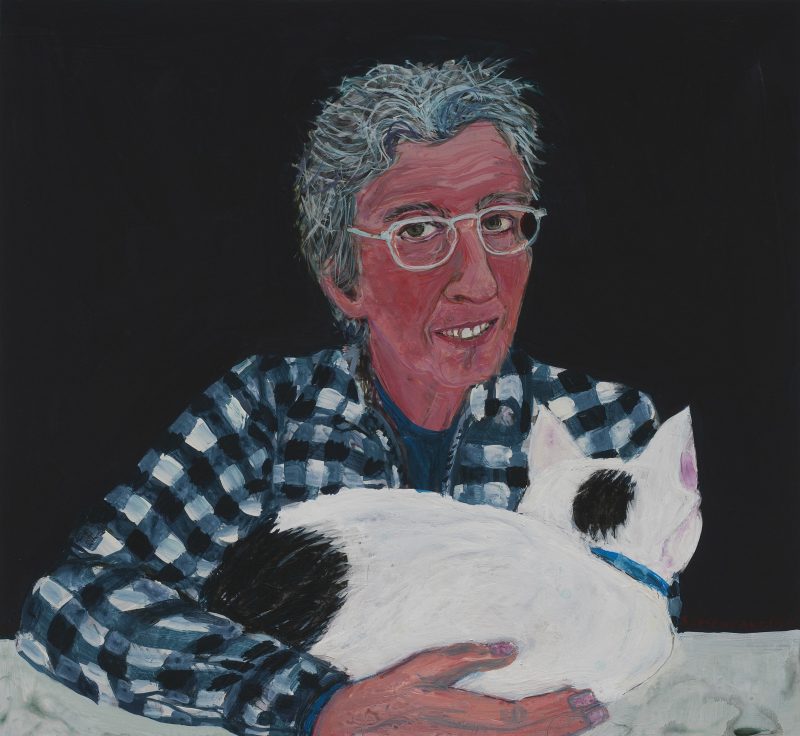
The only beings that appear in McEneaney’s paintings are the artist and her pets–a dog and a bunch of cats presented, I thought, prosaically. It is not exactly animal worship, but more like love for the simplicity, curiosity, and enthusiasm of these companions (along with a fair dose of sentimentality). There are, indeed, a good number of animal portraits in the show, even what I think of as animal still-lives (and perhaps a few too many). But there also is remarkable self-portrait of the artist embracing one of her cats, which reveals, in one fell swoop, the humanity, maturity, and modesty which pervades the entire collection of paintings displayed in the exhibition.
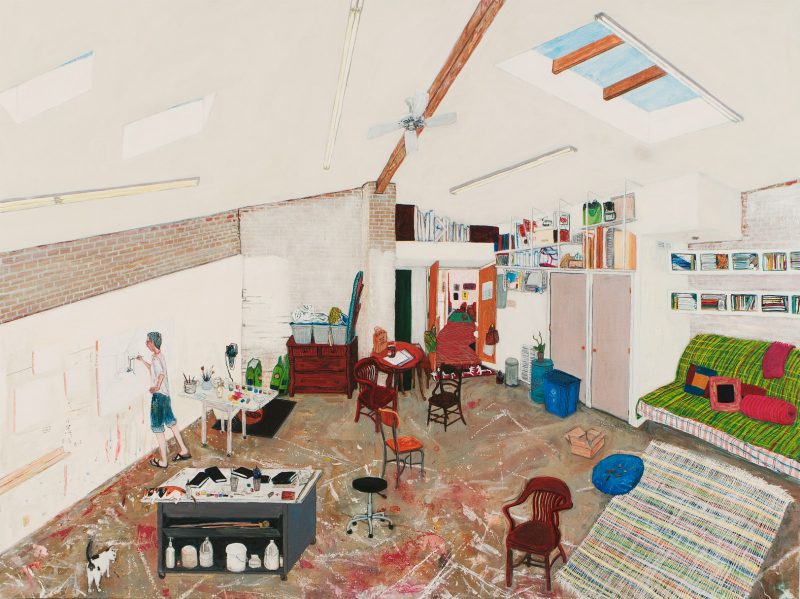
The potential of spaces
You might wonder about the absence of other beings in McEneaney’s autobiographical work, although why would you? You would never ask the question of an abstractionist. I didn’t wonder, I think, because her paintings are so vibrant and lush (even when spare), whether in the depiction of life in her post-industrial Philadelphia neighborhood (Callowhill/The Eraserhood), or in her studio home, studies which comprise the non-four-legged half of the show. This group of McEneaney’s work is about the potential of spaces, and in them the artist plays only a minor role (her living space, for instance, recedes into the distance in the studio/home pieces). Indeed, I would say that these paintings celebrate both the imposing emptiness of spaces and the wonderful structures, things, features, beings, and vegetation that can transform them. And parenthetically, McEneaney’s recent transition from egg tempera to acrylics really has been seamless–the richness and subtlety of coloration is undiminished in these new acrylics.
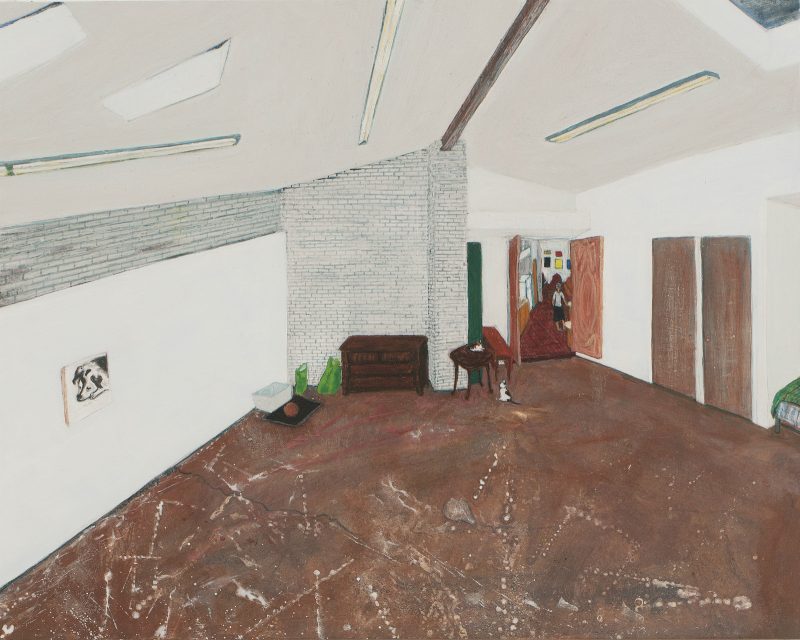
I have always loved and admired McEneaney’s rich and textured floors (reminiscent of some of Bay Area figurative painter Joan Brown’s) and walls and tapestries and textiles, and how some of the paintings include little paintings of paintings hanging on the walls. Indeed, in one of the studio scenes (there are a series of them) hangs a miniature of her “Trestletown from the Wolf,” which is the largest and, to my mind, most impressive painting in the show, in which the artist, her back to the viewer, stands on a rooftop looking over and envisioning the completion of her community project–Philadelphia’s High Line-ish Rail Park–with a glorified version of North Philadelphia spread out in the background. This work, as opposed to the show’s signature piece “When You Wish,” is a more reverberant painting, using a standard romantic trope of the solitary human looking out at a vast magical landscape. The experience of it is sort of like looking out over the Pope’s shoulder onto St. Peter’s Square. It is grand. Even McEneaney’s buildings are lovely, wonderful. Wendy Vogel, the Brooklyn writer and curator, has written a scholarly essay for the stunning catalogue Locks has produced for the exhibition, and explains that this perspective in “Trestletown from the Wolf” is “kind of a Rückenfigur,“ like Caspar David Friedrich’s “Wanderer Above the Sea of Fog,” (1818). Anyway, McEneaney’s pictures within pictures creates a nifty continuity of vision between the studio paintings and the cityscapes in the exhibit.
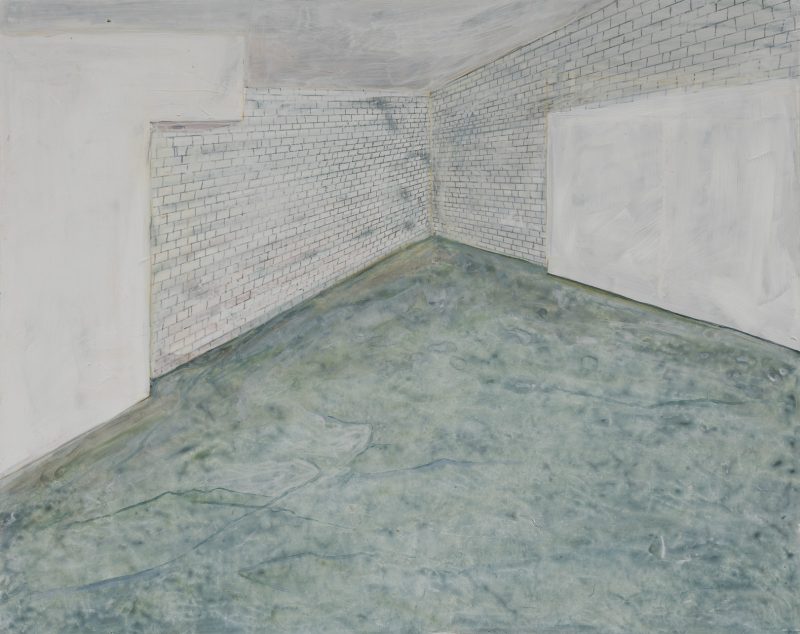
Emptiness, otherworldliness, and simplicity
Always on the lookout for outliers, I was bowled over by McEneaney’s “Empty Studio.” The magnificent floor (a veritable sea), the brickwork and whitewashed walls, the odd angle and vertex of the room–to me this is McEneaney at her most sublime. I want to take it home, but even this, the smallest and least expensive piece in the exhibition, is out of my price range. I don’t know, is it a good thing or a bad thing when a painting of a Lalam rag rug (featured in one of the other studio paintings) costs hundreds of times more than the rug itself? Reviewers tend, for some reason, to disregard pricing–I’m really not sure why. Perhaps so as to appear to inject their judgments with a false sense of purity. Anyway, these are New York prices (ranging up to $65,000). But McEneaney (who sells in New York) is very much of Philadelphia.
I was also enchanted by the boxy, translucent electrical transformer things that show up in a few of the paintings. You can see them in “Trestletown from the Wolf.” They’re apparently McEneaney’s neighbors; I assume they serve us all, and they are sort of otherworldly. I bet they hum. But who else is painting stuff like this? Indeed, you could say the same thing about most of her work. It is the apex of plain originality, originality without fanfare or artifice.
In the past, McEneaney has not shied away from severe subject matter, but none really is evident in this show. Indeed, it seems to me that there is a degree of wishful optimism (even perhaps denial) in some of this work. As hinted above, for example, I thought that there was just too much green and elegant beauty in her depiction of troubled North Philadelphia. Still, to my mind McEneaney is the Kent Haruf of painting–wise and graceful, reserved, careful to get the scene right, and ultimately transporting.
Needless to say, Sarah McEneaney is one of the most renowned, if not the most renowned artist living and working in Philadelphia today. She has been written about in these pages and elsewhere numerous times, and her work has been widely exhibited, collected, and recognized. I also reviewed her November 2014 show, Studio Living, at Tibor de Nagy. Importantly, and to her considerable credit, Sarah McEneaney has been a steadfast supporter of many of our City’s artists.
When You Wish is on display at the Locks Gallery through October 8, 2016.









